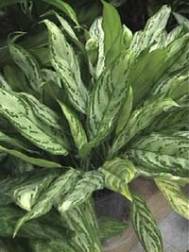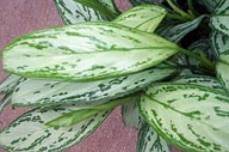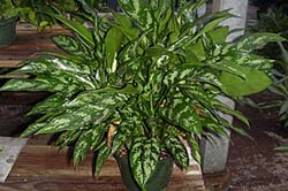|
Plants for your home
(By Mary Efanti)
Aglaonema
 Description - Origin Description - Origin
Take a quick look at the
picture, you will definitely recognize a plant you have seen plenty of times. Aglaonema is one of the most favorite indoor
plants, as it grows easily with minimum care and is ideal to even the most inexperienced amateur
gardener.
Its name is once more totally Greek and its parts are translated as
"aglos: shiny nema: string. Regardless of the Greek origin of its name, aglaonemas come from the tropical forests of
south-east Asia, from Thailand and Cambodia to Vietnam and Malaysia. The first time aglaonemas crossed their natural borders was around 1900 when the plant was brought to America and has been cultivated ever
since. The first new varieties were developed in the 60s; those varieties led to the plants we know today as
aglaonemas. However, new varieties are still being developed in the US mainly, the differences being in the color of its
leaves.
Aglaonemas belong to the aroids
family, together with spathifyllum, dieffenbachia and philodentron. As its
"relatives", it has shiny oval-shaped leaves, with jigged edges, fleshy to the touch and with impressive alternations of various tones of
green. Its flowers look like small white callas and they produce a few yellow or red
fruits. However, the basic reason for cultivating aglaonemas is their wonderful foliage and not its
colors. Depending on the variety, its height can easily reach one meter or over.
Care
 Aglaonema is one of the most ideal indoor
plants. It is very resistant to disease and can be grown in conditions that might
"kill" many other indoor plants. It can be easily adapted to different conditions and this trait makes it really easy to care for and as a result makes it very
popular. Aglaonema is one of the most ideal indoor
plants. It is very resistant to disease and can be grown in conditions that might
"kill" many other indoor plants. It can be easily adapted to different conditions and this trait makes it really easy to care for and as a result makes it very
popular.
Aglaonemas can be grown to any degree of
lighting, from full-light rooms (filtered - never direct sunlight) to the darkest room of hour
home. Of course, the more the light it gets the most impressive the colors on its leaves will
be. If your problem is low light, aglaonemas are an ideal choice. Moreover, they can be easily grown together with other plants in the same
pot.
Although this is an indoor
plant, in warm climates it can be cultivated outdoors as long as you keep it in a shaded
area, preferably facing north.
Aglaonemas love it warm and hate abrupt temperature changes and cold
drafts. Ideally, temperatures should be between 18-30´C and the change in temperature between night and day should not be more than 10´C. A long time in either too low (<15´) or too high (>35´) temperatures may lead to yellowing of leaves or falling leaves and it will hinder its development to a great
extent. So you're your plant around, to a warmer or cooler location depending on the temperatures and keep it away from
drafts, i.e. next to windows or doors. When you decide where to place the pot, remember that temperatures are much lower close to windows than from any other area in your home during
winter.
 Aglaonemas are not very particular to the soil
quality, so any packaged soil is suitable. Make sure though to add some sand into the soil and some pebbles in the bottom of the pot to ensure excellent drainage which is necessary to these
plants. Aglaonemas are not very particular to the soil
quality, so any packaged soil is suitable. Make sure though to add some sand into the soil and some pebbles in the bottom of the pot to ensure excellent drainage which is necessary to these
plants.
Depending on the specific conditions of your
home, watering once a week seems to be adequate. Check the soil before watering and do not let your plant live in soil that is always
wet, also do not let it sit in water and always empty any excess water from the tray to avoid root
rot. Take care not to let the plant go thirsty because the leaves will wilt and may never
recover. You can repot any time of the year avoiding days with extreme heat or extreme cold in order not to stress your plant more than
necessary.
As far as humidity is
concerned, provide as much humidity as possible either by using a humidifier, or with spraying the
leaves. You could also use a pebble tray as we have described in various other
articles. Do not worry too much though because aglaonemas can adapt to less humidity than most indoor
plants.
Use any liquid or tablet form fertilizer but use approximately ? of the dosage described on the label to avoid damaging the roots or the tips of its
leaves. In very young plants, avoid fertilizing until the plant is around 6 months
old, while in mature plants you should fertilize 3 times per year (every 4
months).
You can easily propagate aglaonemas from cuttings. Cuttings can be placed in water until they grow roots or they can be planted directly into
soil. Aglaonemas can grow in water for a long time, provided that you replace the water often and that you carefully remove any algae from the inside of the
container. Same as pothos (devil's ivy), aglaonemas can be grown in small glass vases with water that can be placed on your bathtub or on
window-sills, creating small tropical areas in minimum space.
As we already mentioned, one of its basic advantages is that it is almost
disease- and insect-proof. However, to be on the safe side, keep leaves very clean and check often for
aphids, thrips, or spider mites that may have affected other indoor plants.
You have plenty of good reasons to buy aglaonemas. They are beautiful, easy to
grow, hardy, needs no specific care, it adapts easily, is suitable for low light
rooms, with quick growth, even in water, extremely easy to propagate . . . what else could you ask
for?
Mary Efanti
[email protected]
|
